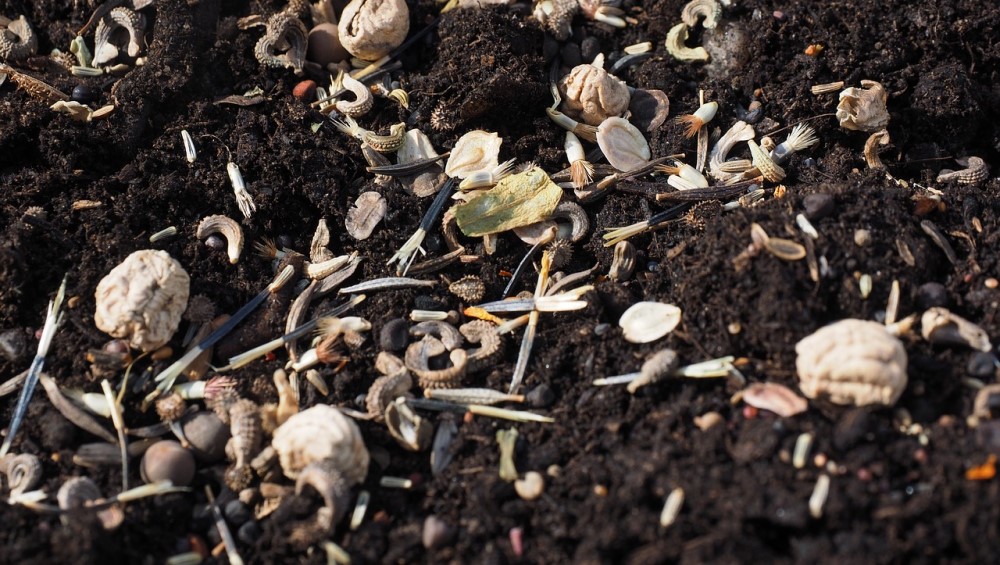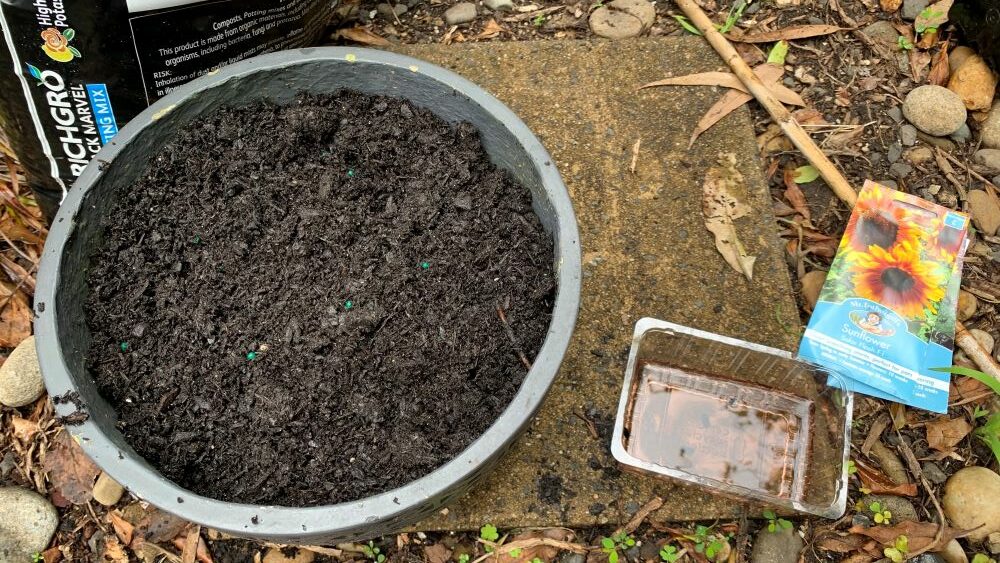Planting seeds in potting soil is a simple and rewarding way to start a garden. Begin by selecting a clean container with drainage holes and filling it with moistened potting soil. Then, use a pencil or your finger to make small holes in the soil, drop one or two seeds into each hole. Cover them lightly with soil and water them gently with a spray bottle. Put them in a sunny location and keep the soil moist.

Safety First: When working with potting soil, make sure it is damp. You may want to wear a mask so you don’t breathe in the particles from the soil as they can carry bacteria. Wearing garden gloves is also a good idea and make sure you wash your hands thoroughly straight after.
4 Steps to plant seeds in potting soil
Check out these easy steps to plant seeds in potting soil.
1. Choose an area to plant your seeds
Decide where you are going to plant your seeds. This could be in a pot, raised bed or seed trays. Some seeds will do better if planted in a seed tray first. These include tomato, capsicum, broccoli, cabbage as well as many flowers. Seeds that would be better planted straight into a garden bed include carrot, snow peas and beans.
2. Add potting soil
Add the potting soil to your tray or bed. Place enough so that it is almost to the top of the pot or tray. Allow ¼ of an inch space to the top of the seed tray or pot to stop the soil from falling over the edge when watering.

3. Make a small hold for the seeds
If your seeds are larger, make a small hole or line to plant your seeds in. You can then gently cover the seeds over with your hand or spade. If your seeds are small, like lettuce, just scatter them over the top of the soil. You can then gently sprinkle with a little more potting soil.

4. Water your seeds gently
Gently water your seeds in with a spray bottle or with the spray function on your hose. Give them a good soak and keep them moist until they sprout. If you have planted your seeds into a tray you can move them back into a spot that is shaded throughout the day. As they grow you can gradually move them out to get more sun and then plant them out in your garden.

TIP: Seeds generally like to be covered by as much soil as they are thick. Make sure small seeds are only slightly covered with soil, otherwise they won’t be able to push up through when they sprout.

Using seed raising mix to grow seeds
Seed raising mix is very similar to potting soil but doesn’t have all of the larger pieces in it. Think of it like sieved potting soil. It generally won’t have any added fertilizer as the seeds have all the food they need inside them to sprout.
This also encourages the seeds to send their roots down deeper in the soil and will grow a healthier root system. Because there are little nutrients in the soil, it is important to plant your seeds out in a normal potting mix as they grow bigger.
Check out this video showing the difference between growing in seed starting mix vs potting soil.
Is seed starting mix necessary?
Seed raising mix is a great way to start your seeds but you will find plenty of success growing seeds in potting soil. You can also make your own.
How to make seed starting mix
Here are 3 recipes to get your seeds started.
| Seed Starting Mix 1 | Plant straight into coconut coir |
| Seed Starting Mix 2 | 1 Part perlite and 1 part coconut coir |
| Seed Starting Mix 3 | 1 part perlite, 1 part vermiculite and 1 part coco coir. |
I have mentioned vermiculite in the mix above. Vermiculite looks like tiny gold or brown rocks. It is aluminum-iron magnesium silicates which are crushed and heated. As they are heated, they expand which when added to the soil helps it to hold air and water.
It holds more water than perlite, but less air which is why adding both to your soil mix will give you a good balance.
You can plant most seeds straight into coco coir and they will sprout. The 3-part mix however is the best option for seed growing success in pots or trays.

Should I add perlite to my potting mix for growing seeds?
Perlite can be a great addition to your potting soil mix. It is actually a volcanic glass that they heat to 1600 degrees Fahrenheit. This makes it pop like popcorn so it holds air. It also holds moisture on its surface so it is great for keeping the soil moist for seeds.
It is great to keep the soil structure light and airy to allow your seeds to grow through. You could also add it to the top of your garden beds if your soil is a bit heavy or stuck together. Just sprinkle on the top and rake it in. Perlite, like potting soil can have fine particles or dust so it is best to wear a mask when handling it.
Where do I buy perlite?
Your local garden center or hardware store can be a great place to start. Here in Australia, I buy mine from Bunnings but it is also available online at Amazon.
What is the best soil to plant seeds in?
If you are planting into seed trays a seed starting soil mix is a great way to start your seeds off. A good garden soil is also a great place to start bigger seeds like peas and beans.
How to grow seeds indoors
You can grow the seeds in the same way indoors. A home seed growing kit with a lid is also a great way to start seeds off indoors as this will help to keep in the humidity. Place your seeds near a window and they will sprout away. The key to success with seeds is to make sure you always keep them moist.
Summary
Planting seeds in potting soil is easy. Start by picking a container with drainage holes and fill it with moistened potting soil. You can then make small holes in the soil using a pencil or your finger. Drop one or two seeds in each hole, and cover them with soil before watering gently and placing the container in a sunny location.
Happy growing.
I am an accredited practicing dietitian, experienced gardener and a dedicated cook. I love writing and sharing my experience so you can learn from my successes and mistakes.
